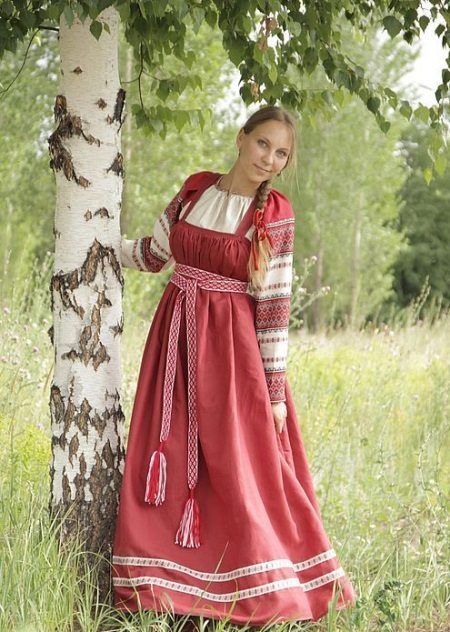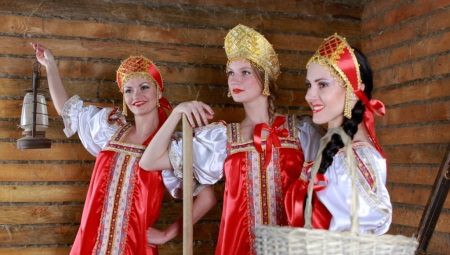Despite the change of names and political system, Our country bears the ancient and special cultural values of our ancestors. They consist not only in art, traditions, characteristic features of the nation, but also in national costume.
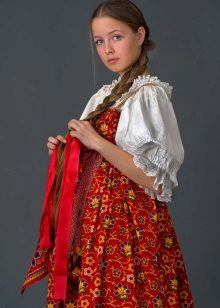

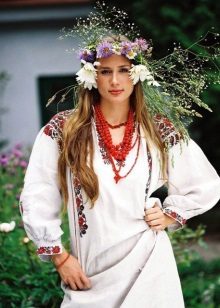
History of creation
Old Russian costume is considered to be the national clothing of the population of Russia of the pre-Mongol invasion and Moscow Russia, until Peter I came to power. Nand the formation of the special features of the outfits was influenced by several factors at once: close relations with Byzantium and Western Europe, withlevel climatic conditions, activities of the overwhelming majority of the population (cattle breeding, tillage).
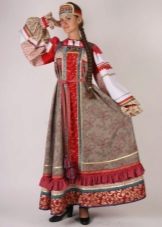


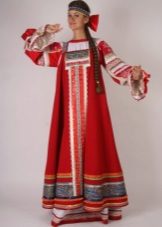
The clothes were sewn mainly from linen, cotton, wool and in itself it had a simple cut and a long, closed style. But those who could afford it, in every possible way decorated a modest outfit with immodest decorative elements: pearls with beads, silk embroidery, embroidery with gold or silver thread, fur trim. The national costume was also distinguished by its bright colors (crimson, scarlet, azure, green shades).
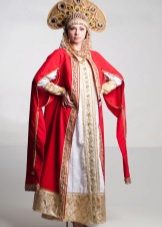
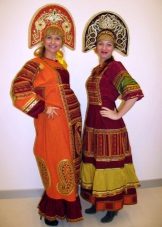
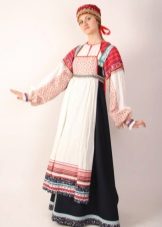
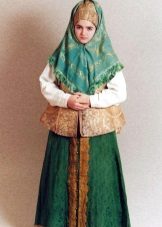
The costume of the era of Muscovite Russia from the 15th to the 17th centuries retained its characteristic features, but underwent some changes in the direction of a more intricate cut. The differences in the outfits of the population were influenced by the class division: the richer and more noble a person was, the more layered his outfit was, and they wore it both indoors and outdoors, regardless of the time of year. Oar and fitted clothes appeared, and Eastern and Polish culture had their influence. In addition to linen, cloth, silk, velvet materials were used. There is a tradition to sew bright clothes and richly decorate them.

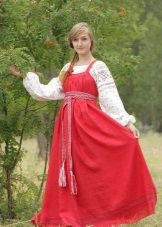
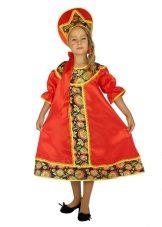
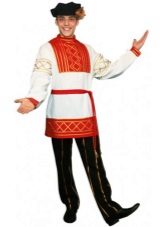
At the turn of the XVII - XVIII centuries, Peter I issued decrees prohibiting everyone, except peasants and priests, from dressing in national costumes, which played a negative role in their development. Decrees were issued in order to establish political relations with European allies, to adopt their culture. The people were forcibly instilled a taste, replacing chic, but long-sex and uncomfortable multi-layer clothes with more comfortable and lightweight pan-European ones with short caftans, low-cut dresses.
The Russian national costume remained in the use of the people and the merchants, but nevertheless adopted some fashion trends, for example, a sundress belted under the chest. In the second half of the XVIII century, Catherine II made an attempt to return some national identity to the fashionable European costumes, especially with regard to the materials used and the splendor of the finish.
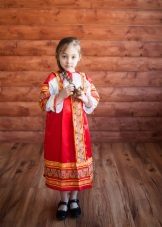
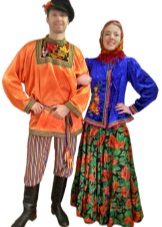
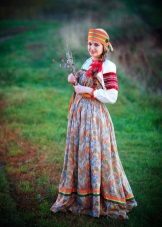
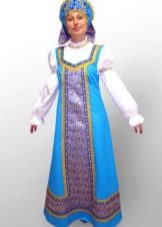
The 19th century returned the demand for a national costume, in which patriotism, which was growing due to World War II, played a role. Sundresses and kokoshniks returned to the household of noble young ladies. They sewed from brocade, kisei, and cambric. Appearing clothes, for example, “women's uniform”, may not look like a national costume, but still had a certain symbolic division into “shirt” and “sundress”. In the XX century, due to cut off from European suppliers, a kind of return of national outfits occurred, and in the second half, in the 70s, it was no more than a fashionable trend.
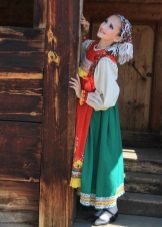
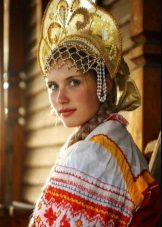
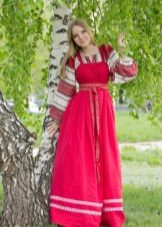
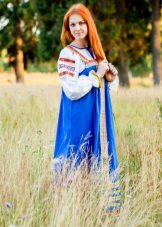
Despite the fact that a certain traditional set of clothes can be distinguished, due to the large territory of the country national costume took characteristic features in certain regions. The North Russian set is word of mouth, and a slightly more ancient South Russian one is slovenial. In central Russia, the costume was more similar to the north, but there were features of the southern regions.
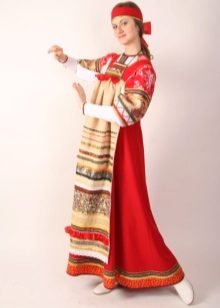
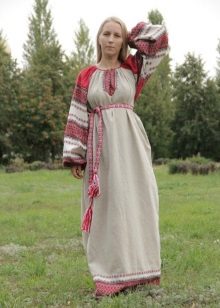
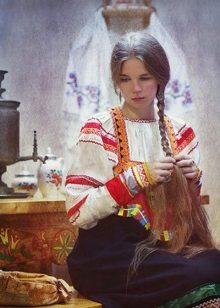
Sundresses were oar and deaf, had a trapezoidal style, sewn from one or more paintings. More simple sundresses are products on the straps, straight cut. The holidays were made of silk and brocade, and for daily affairs and life - cloth and chintz. Sometimes on top of a sundress they put on a murderer.
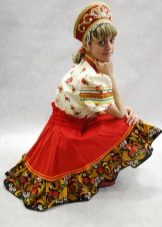
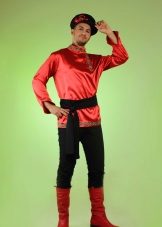
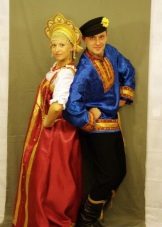
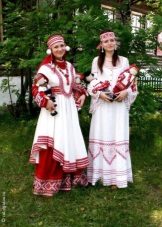
The South Russian costume included a long shirt and a hip skirt - ponyev. Poneva was dressed over a shirt, wrapping around the hips and securing with a woolen cord at the waist. It could be both oar and deaf, complemented by an apron.
Each province had its own preferences and features in the decoration, colors, elements and even names. In Voronezh province, ponevs were decorated with orange embroidery, geometric symbols were common in Arkhangelsk, Tver and Vologda, and what was called “queen” in Yaroslavl province was “soroklin” in Smolensk.



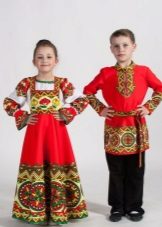
In the modern world its own special fashion, but among the people there is an interest in the origins, national dress. Traditional costumes can be seen in museums and sometimes at exhibitions, they are used for theatrical and dance performances, on holidays. Many designers and fashion designers use the characteristic features of Russian folk costume in their collections, and some of them, like researchers, delve into a detailed study, for example, Sergey Glebushkin and Fedor Parmon.

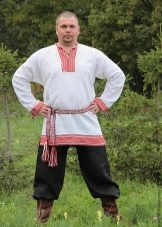

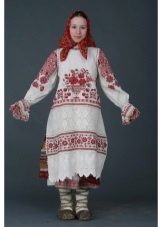
Features
Despite the large differences in the regions and even in the provinces, one can distinguish the common characteristic features of national Russian clothing: layering, flared silhouette, bright colors, rich finishes.
The complexity of the outfit was characteristic in all sectors of the population. While among the working people the costume could consist of seven elements, the rich nobles already had twenty. One clothes was worn on top of another, whether it was oar, deaf, cape, with clasps and ties. A fitted silhouette is practically not peculiar to the national, on the contrary, in honor are free, trapezoidal styles, and the length in most cases is half.
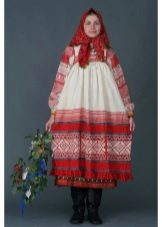
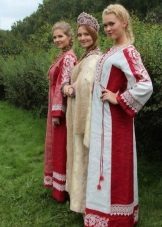
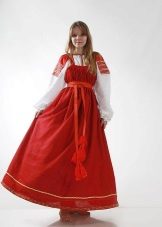
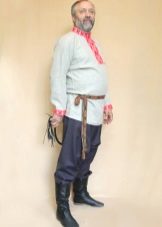
For a long time the Russian people had a passion for bright colors that brought joy. The most common are red, blue, gold, white, blue, pink, raspberry, green, gray. But besides them, each province had its own preferences in shades, of which there were a great many: lingonberry, cornflower, smoky, nettle, lemon, poppy seed, sugar, dark clove, saffron - and these are just a few of them. But black was used only in elements of some regions, and then for a long time was associated exclusively with a mourning outfit.
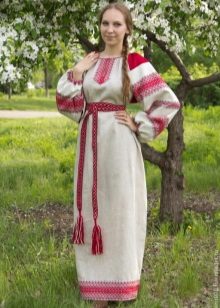
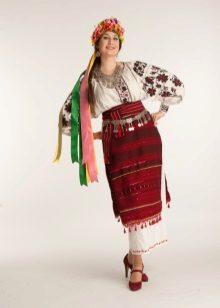
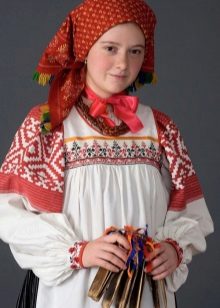
Since ancient times, embroidery was sacred for Russian national costume. First of all, she always acted not as decoration, but as a talisman, protection from evil spirits. Pagan symbolism did not sink into oblivion even with the advent of Christianity, but the ornaments acquired new elements, combining old Slavic and new church motifs. Protective amulets embroidered on the collar, cuffs, hem. The most commonly used color scheme was red threads on a white canvas, and after that, multicolor began to spread.
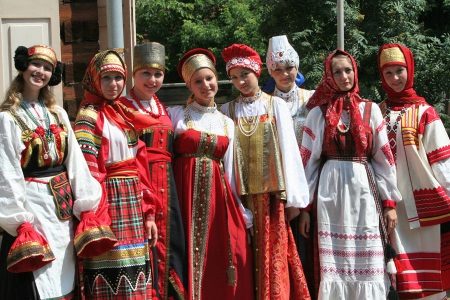
Over time, embroidery acquired a more decorative character, although it carried the plots of ancient ornaments and patterns. The development of gold embroidery, embroidery with river pearls, crafts, elements of which were transferred from dishes and furniture to clothes, also played a role in changing the meaning. The original Russian pattern suggests geometric strict forms, almost complete absence of rounded elements, which was due to the technique of embroidery. The most common motifs and specific symbols are: the sun, flowers and plants, animals (birds, horses, deers), female figures, huts, figures (rhombuses, beveled cross, Christmas tree, sockets, octagonal stars).
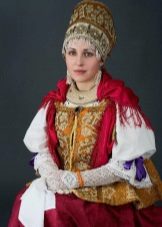

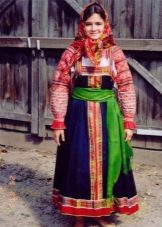
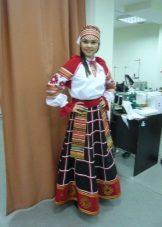
The use of elements of crafts, for example, Khokhloma or Gorodets painting, came into use later.
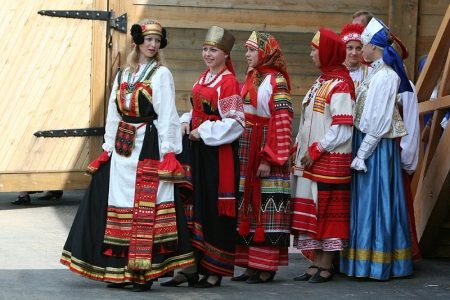
In addition to embroidery, the nobility's outfits were decorated with buttons (wooden buttons entwined with chanel, lace, pearls, and sometimes made of precious stones), torifle and fur on the hem and neck, stripes, necklaces (embroidered with pearls, snap-on collar made of satin, velvet, brocade). Of the additional elements - false sleeves, belts and sashes, bags sewn to them, jewelry, couplings, hats.
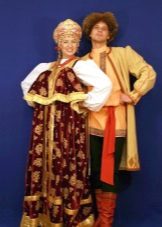
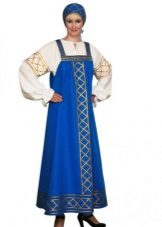
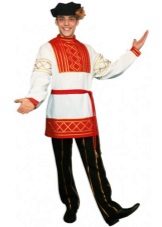
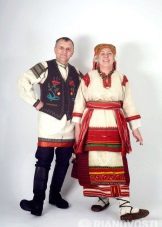
Varieties
The modern women's national costume is a kind of compilation of several characteristic features at once, because in fact there are a lot of types and options of the original Russian costume. Most often, we imagine a shirt with voluminous long sleeves, colored or red sundress. However, the simplified version, although it is the most common, is far from the only one, since many designers and simply folk artists return to the traditions of their regions, which means that various styles and elements are used.


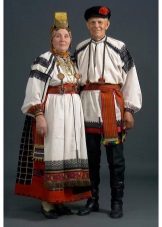
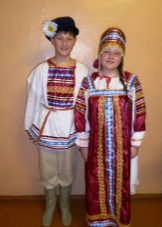
Costumes for girls and children very similar to adult models and include shirts, shirts, pants, sundresses, aprons, skirts, hats. Completely children's models can be sewn with short sleeves, for added convenience, and, in principle, have a general appearance of the dress, but with certain national elements. For teenage girls there is a greater variety of adult models, and not only sundresses and shirts, but also fur coats, ponev.
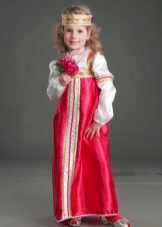
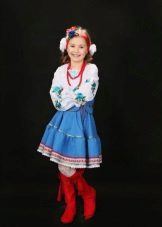
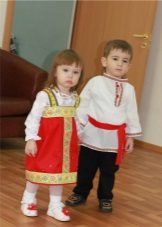
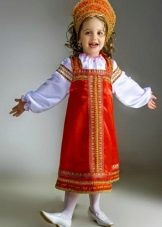
Winter folk costume is a lot of heavy clothing. In addition to a warm woolen sundress, a part for a cold season is a short oar coat, openfold, a murmur, quilted jackets, fur coats, woolen stockings, warm hats and shawls. In richer options, natural fur is present.
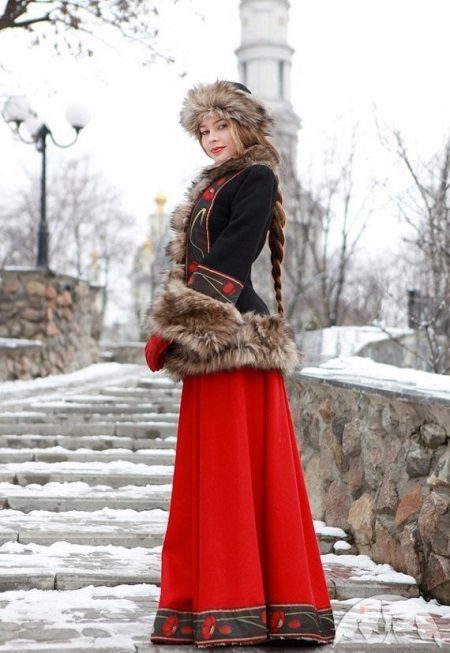
Festive
Stage costumes There are two types: the most similar to the real national costumes (for the choir), in which the rules of tailoring are respected and stylized, in which there are many traditional elements, but necessary deviations are allowed.For example, outfits for a round dance, Russian folk dance or other dance styles should, first of all, be as comfortable as possible, so skirts can be shortened, overly lush, and sleeves not only long, but also ¾, “lanterns”. In addition, stage costumes, unless it is a theatrical production, are richly decorated and as bright as possible, attracting attention.
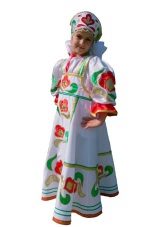
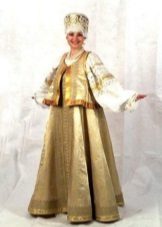
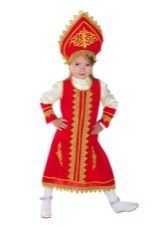
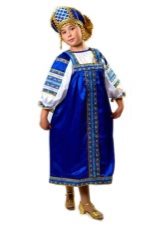
Wedding costumes look especially elegant and luxurious. For the rich and noble, they were sewn from heavy expensive fabrics, and the people could afford simpler ones, such as linen. White color was considered a symbol of holiness, so wedding dresses were made in other colors - silver, cream or multi-colored, elegant. Mandatory was the presence of embroidery of flora symbols - berries, leaves, flowers. In addition, the concept of a wedding dress included four sets of clothes at once - for pre-wedding festivities, weddings, ceremonies and celebrations.
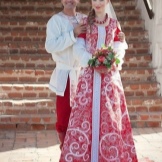
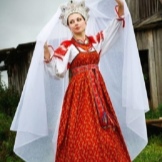
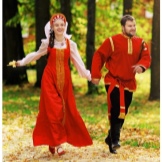
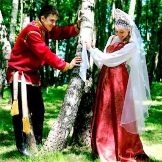
Folklore costumes are as close as possible to the source. Craftsmen recreate costumes with the characteristic features of a particular region, province. Carnival costumes can be similar to folklore or, conversely, can be greatly simplified. However, holiday dresses are undoubtedly bright and decorated as much as possible.

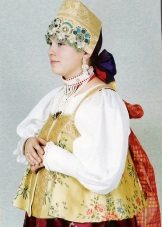

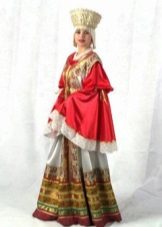
In modern style
National color - one of the special styles in fashion, because it involves the interweaving of modern fashion trends and traditional features in the culture of one or another people. Slavic and Russian motifs are loved not only by our compatriots, but also by some foreign designers. In such clothes you can appear at any event, while looking ultra-stylish and appropriate.
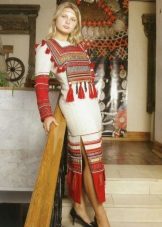
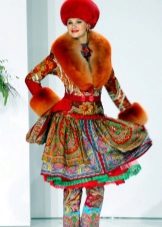
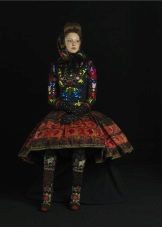
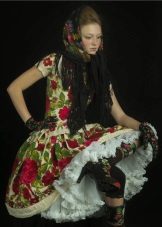
The modern style took over primarily the colors, ornaments, embroidery. Familiar patterns are found on trendy pencil skirts, knee-length dresses, blouses. Long dresses and sundresses on the floor look the most authentic national outfit. It has been adopted by fashion and individual elements, especially with regard to stoles and shawls, shoes, hats.
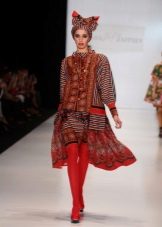

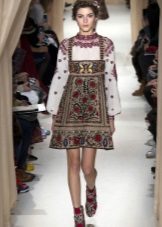

Items
Folk costume includes clothes, shoes, hats. The main element is a long shirt, over which a sundress, skirt or poneva is worn, fixed with a special belt. On top of poneva and skirts sometimes wear an apron. On top of a shirt and sundress, a murderer and a fur coat are permissible.
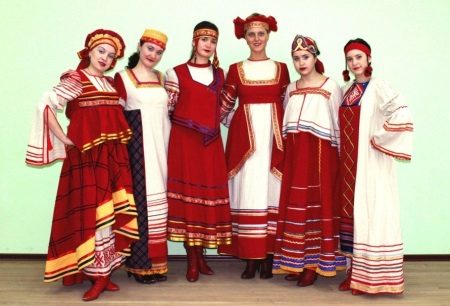
The traditional headdress that has come down to our times is the festive kokoshnik, however, besides him, part of the costume includes hoops, ribbons, bandages, scarves. Authentic outfit involves the mandatory use of jewelry, pearl necklaces, embroidered detachable collars. Among the shoes should be called ankle boots and long boots, bast shoes, felt boots for the winter.
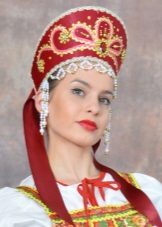
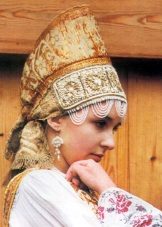
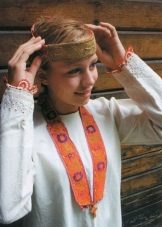
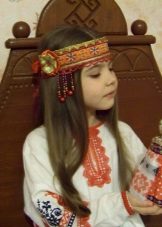
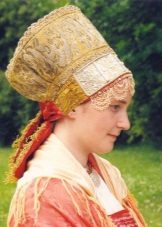
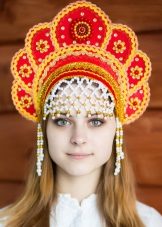
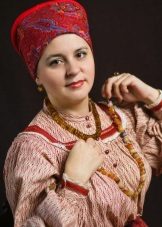
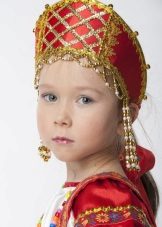
the cloth
In Russia, linen, poskonny, cloth, silk, velvet, woolen materials were used for sewing clothes, and kindyak was used as a lining. These fabrics were available to the vast majority of the population. But a rich estate could afford expensive outfits made of taffeta, kamka, brocade, obyar, satin, coutine, satin, and motley.
Modern costumes are made of cotton, gabardine, satin, linen, viscose silk, knitwear, crepe satin, chiffon, tulle, jacquard.
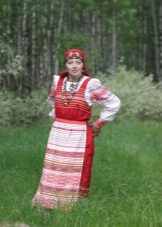
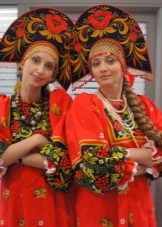

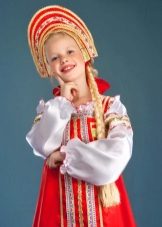
Where to buy or rent?
It is easiest to rent a Russian folk costume in carnival clothing stores. Most often, the costumes are pretty monotonous, simple, made from affordable cheap materials. A dance or stage costume can be sewn on orders from costumers and at the studio that provide such services. But you can buy a ready-made outfit on many sites engaged in sewing not only stylized clothes, but also similar to traditional Slavic. These sites are easy to find in a search engine, and one of the most famous is the Russian Vintage store (bestavantage).
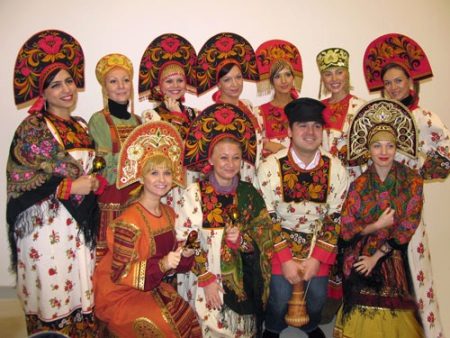
The images
Costume from the "Enchantment of the Russian North" collection.An elegant sundress of saturated blue color with a floral black-and-orange ornament, beige shubeyka and coruna in tone (headdress), and on top a warm shawl. Since the suit is winter, the most suitable shoes are felt boots.
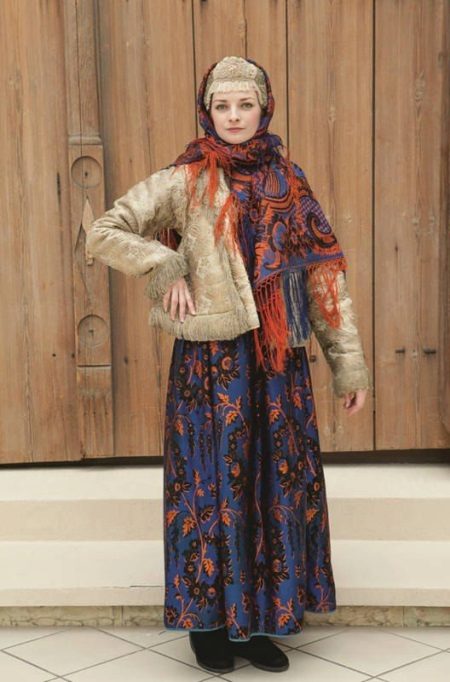
Loose red sundress on the straps, floor length, belted under the chest belt, embroidered with ornaments. Under the sundress, a shirt with long straight sleeves and a print with traditional patterns.
